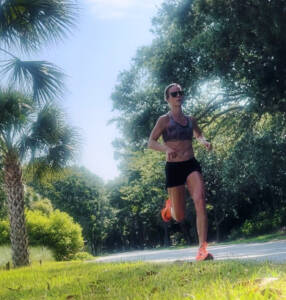This week I was running while on vacation in Charleston, South Carolina. It was so hot. So humid. I was just doing an easy run but it felt the opposite of easy. Then I remembered why—I was about to get my period. PMS symptoms and running don’t go together well. I felt hotter and more tired than usual.

Indeed, PMS symptoms do include a higher core body temperature and fatigue. My run didn’t just feel harder, it was harder. My body was working overtime to cool itself in the hot Low Country sun and humidity. Meanwhile, the cascade of hormones was draining my energy.
Related: Should I Run a Race on My Period
It’s becoming more common knowledge now that menstrual cycles affect running. However, study after study shows that how menstrual cycles and running impact one another isn’t straightforward.
In fact, the only common thread between how menstrual cycles affect runners is that it is individual. Some runners aren’t affected by PMS symptoms. Other runners can barely get out of bed during the luteal phase. Some runners perform at a higher level during their periods. Period cramps debilitate others.
The key here is tracking your symptoms so you know how they affect you so you can shift training as needed.
I have some athletes who are really impacted by their menstrual cycles. And we adjust their training to meet them where they are so they can remain consistent. After all, taking an extended break every 4 weeks isn’t ideal in a sport where consistency is queen.
I want to help you with your PMS symptoms and running. In this article, I will cover:
- A quick overview of the menstrual cycle
- What is PMS and what common PMS symptoms can affect running
- Does running help PMS?
- Expert tips to manage PMS symptoms so you can run
(Note: I am not a doctor, if you have concerns, please talk to yours).
Let’s go!
First, an overview of your menstrual cycle:
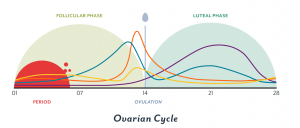
credit: helloclue.com
- Phase 1: Menstruation: Your period begins Day one of your menstrual cycle. This is when hormones are the lowest and potentially priming you best to perform.
- Phase 2: Follicular phase: This phase begins when your period starts and ends around day 13-14 when you typically ovulate. During this time, estrogen rises and peaks as an egg is prepared to be released.
- Phase 3: Ovulation: This is around day 14 of your cycle when the egg is released. PMS symptoms may happen on this day.
- Phase 4: Luteal phase: The luteal phase is between your ovulation (day 14 or so) and the start of your next period (day 28 or so). So the luteal phase is usually around day 14-28 (to 40—a normal cycle can be 40 days long). This is when estrogen and progesterone start to rise, triggering PMS symptoms. They drop when your period begins and restarts the menstrual cycle.
Related: What to Eat On Your Period
What is PMS?
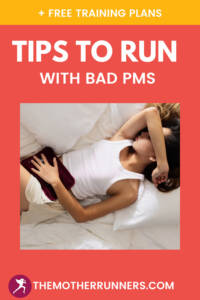
PMS stands for Pre-Menstrual Syndrome and it is a collection of physical and emotional symptoms that occur in the days leading up to your period (luteal phase).
What are PMS symptoms that can affect running?
Common PMS symptoms that can affect running include:
- Mood swings
- Lack of motivation, feelings of depression, hopelessness, and anxiety
- Fatigue
- Feeling hot or night sweats
- Bloating, weight gain, and tummy troubles
- Headaches
- Trouble sleeping
- Difficulty focusing
Yes, yes, and yes…I experience all of these in varying degrees during my PMS and period. If you do too, take heart. Running, even if it is the last thing you want to do, can help ease PMS symptoms.
Does running help PMS?
There are several studies that show that running helps PMS. In fact, regular aerobic exercise is the top treatment for PMS symptoms from the American College of Obstetricians and Gynecology.
Here’s how running helps PMS:
Research shows that running during PMS can help combat feelings of depression and fatigue during the luteal phase (PMS phase) of your menstrual cycle.
Another study backs this up–showing that women who completed just three hourlong sessions during their PMS had less physical and emotional PMS symptoms. Why? Running releases a host of feel-good chemicals, neurotransmitters, and hormones that boost serotonin levels and moods.
Running can also help period cramps. The increased blood flow of aerobic exercises has been found to decrease period cramps and bloating.
Related: How Running Makes You Happy
Indeed, I have found that running has helped my overall outlook or mood during PMS. Running also relieves period cramps. I have them right now and am about to head out for my long run. I do not want to take Advil before my long run, but I know the increased blood flow will eventually relieve my PMS cramps.
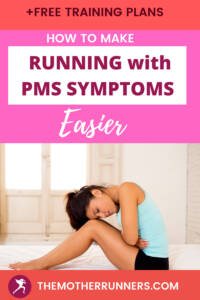
Related: Should You Take Advil Before You Run?
Do you run slower before your period?
Research is inconclusive about how our menstrual cycles affect our running. Most studies show that it really just depends on the person. However, there is some evidence that running performance can decline during the luteal phase (PMS before your period) due to the rise in core body temperature—particularly during endurance events.
And, running performance improves actually on your period because that is when hormones are the lowest (and we are most like men).
Tips to Manage PMS Symptoms for Running
In most cases, running can help PMS symptoms and period pains. Here are some tips on how to deal with PMS symptoms so you can keep running:
PMS Headache.
I will often get a PMS headache or migraine headache before my period. If it is really bad, all I can do is lay in a dark room with a cold cloth on my head. I usually take Excedrin Migraine and Tylenol when I feel it coming on. (I used to take daily medication for migraines).
In most cases though, if my headache is not debilitating (which they can be—I only wish migraines onto my worst enemy), I have found that easy running eases the pain of my PMS headaches.
Research backs this up. Studies have found that light exercise can help relieve headaches by changing the nitric oxide levels in your blood. The key is to not run too intensely or for too long. I recommend keeping it to easy runs under an hour and be sure to fuel and hydrate well.
Related: How Your Period Affects Your Running
Period cramps.
Research shows that exercise like running can reduce menstrual cramps by increasing blood flow. I experienced that this morning. Before I went out for my long run, I had bad period cramps. They went away during my run (but returned afterward).
If you have period cramps that are so bad you feel like you cannot run, ibuprofen like Advil or Aleve can help. However, talk to your doctor first as taking ibuprofen before, during, or after running has risks.
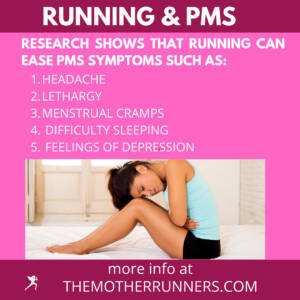
Related: Should I Take Ibuprofen Before Running?
Fatigue and sleep issues.
Research shows that running can help improve energy levels and sleep. When you haven’t been able to sleep due to hormonal changes during PMS, running may feel like the last thing you want to do. However, I encourage you to head out the door for a short run and see how you feel.
You will likely find that your energy improves, and you will sleep better that night.
However, sometimes the fatigue is insurmountable. Today on my long run (in the high heat and humidity of Charleston, SC where we are vacationing), I felt like lead the whole time. The elements plus my period gave me a ticket to ride the struggle bus.
In these cases, if you can, it’s best to use them as mental strength days. Stick with it the best you can. Throw out pace goals and run by effort for what feels best.
Related: How to Run by Effort
Lack of motivation.
PMS can often bring on a lack of motivation and even feelings of hopelessness and depression. But study after study shows that running triggers a cascade of feel-good physiological changes that boost your mood and outlook (even permanently in your brain over time!).
Do not let PMS symptoms win. I promise you will feel so much better (including about yourself), if you lace up and move your body.
Related: How to Get Your Running Motivation Back
Feeling hot during your period.
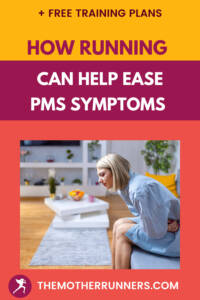
PMS can raise your core body temperature by almost half a degree Fahrenheit. If you’re running in high heat and humidity (like I was), then you will feel even this slight difference. It makes your body work harder to keep cool and your rate of perceived effort will increase.
When this happens, it’s best to take measures to keep cool like using a cooling towel, ice bandana, ice in your hat and sports bra, cool water bottle with a sports drink, seek shade, and run by effort and time over pace and distance.
Related: Tips to Make Running in Humidity Feel Easier
Tummy troubles.
If you struggle with constipation or diarrhea during PMS, aim to eat simple foods with fiber to stay regular. Personally, I think it is very important to wake up early before your runs to ensure you “go” as running with that in your intestines can put a strain on your gut.
Related: How to Make Sure You Poop Before You Run
Overall ickiness.
Listen, I get it. Sometimes PMS can just make you feel awful and there is little you feel like you can do about it. In this case, here’s what I suggest:
-
Alter your rest and recovery days.
If you feel too terrible to run, alter your schedule so that your worst days are the days you recover—either a complete rest day, yoga day, cross-training day, or short run day. The good news is, for most people, the days we feel absolutely terrible each month are limited to a few.
-
Take a down week.
If PMS is often a time when you feel awful and running feels much harder, this is a time when you should take your “down week” or “cutback week.” A down week or cutback week is a slight reduction in training volume of about 20-30 percent.
Most training plans should include a down week about every four weeks to absorb the training and prevent injury. Plan your down weeks during your PMS weeks.
-
Boost your nutrition.

Running this morning helped relieve my period cramps.
Eating foods with carbohydrates, iron, magnesium, omega-3 fatty acids, calcium, fiber, and Vitamin D may help alleviate PMS symptoms, studies show. Supplementing with magnesium, zinc, and omega-3 fatty acids in the week before your period can also help reduce cramps and tummy troubles, and raise energy levels.
-
Consider birth control.
You can talk to your OB/GYN about taking birth control to ease the symptoms. Mine suggested I take birth control, however, I have not yet. There are potential drawbacks to taking birth control including declined performance, decreased muscle mass, and a decline in bone density. I talk more about that here.
Related: Should Runners Take Birth Control?
Related: How to Tell If You Have Low Iron
What about race day?
As you read this, I am sure you are wondering—but what if my PMS symptoms are bad on race day? This is why I encourage you to continue to run during PMS and on your period so you can build that mental strength and add tools to your toolbox for how to manage your PMS symptoms while running.
If your PMS symptoms are really bad, you can sign up for a backup race or alter your race goal. Often though, you may find that the race day jitters and high will overcome any PMS symptoms that typically plague you. Get more info on running during your period here.
Related: Should I Run a Race on My Period
By the way, I would argue that having discomfort during with PMS is much better than missing your period which comes with real danger. If you are not getting your period regularly, please talk to your doctor about the potential for RED/s ASAP. It is something many female endurance athletes struggle with, including myself in my late 20s, and has big health risks.
Read more info about it RED/S here.
If you want guidance with your running goals, including running during your period or PMS, check out my run coaching services. Also, be sure to check out my free training plans:
- Postpartum Training Plan
- After a Break Training Plan
- 5k Training Plans
- 10k Training Plans
- Half Marathon Training Plans
- Marathon Training Plans
- Strength Training Plan

